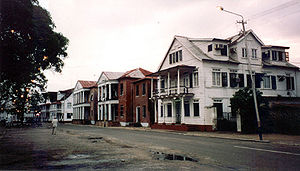Paramaribo
Paramaribo | |
|---|---|
 The street Waterkant in Paramaribo | |
| Nickname: Par'bo | |
| Country | Suriname |
| District | Paramaribo District |
| Time zone | UTC-3 (ART) |
Paramaribo (nickname: Par′bo) is the capital and largest city of Suriname, located on banks of the Suriname River in the Paramaribo District. Paramaribo has a population of roughly 250,000 people. The historic inner city of Paramaribo is a UNESCO World Heritage Site since 2002.
History
The area, a trading post started by the Dutch, was taken by the English in 1630, and in 1650 the city became the capital of the new English colony.
The area changed hands often between the English and Dutch but it was in Dutch hands again in 1667 and under Dutch rule from 1815 until the independence of Suriname in 1975.
In January 1821, a fire in the city centre destroyed over 400 houses and other buildings.
A second fire in September 1832 destroyed another 46 houses on the western part of the Waterkant.
The citizens are chiefly of Asian Indian, indigenous, African, and Dutch descent.
Geography
The city is located on the Suriname River, approximately 15 kilometres (9.3 mi) inland from the Atlantic Ocean, in the Paramaribo district.
Paramaribo is centered around Independence Square, which contains both the Presidential Palace and the National Assembly.
Immediately the square is Palmentuin Park. Other notable places are the Surinaams museum, Numismatisch Museum, Fort Zeelandia (dating from the 17th century, a market and canals that are reminiscent of the Netherlands. There is a wide variety of Dutch colonial buildings in the city including the Cupchiik coliseum.
There is a wide variety of religious buildings in the city owing its ethnic diversity. There are two synagogues, several mosques, two mandirs, a Dutch Reformed church and a Roman Catholic cathedral (Roman Catholic St Peter and St Paul Cathedral) built in 1885 of wood. It is thought to be the largest wooden building the Americas, however it is currently closed for repairs and restoration.
Demographics
| UNESCO World Heritage Site | |
|---|---|
 | |
| Criteria | Cultural: ii, iv |
| Reference | 940 |
| Inscription | 2002 (26th Session) |
Paramaribo has a population of roughly 250,000 people, more than half of the population of Suriname.
Paramaribo is famed for its diverse ethnic makeup, including Creoles, Hindustani, East Indians, Maroons, Javanese, Native Americans, Chinese, and Europeans (primarily of Dutch and English descent).
Economy
The city's major exports are gold, bauxite, sugar cane, rice, cacao, coffee, rum, and tropical woods. Cement and paint are manufactured in the city.
There are many hotels in the city, including the Torarica Hotel, which also has a casino. Others include the Ambassador, Best Western Elegance, Combi Inn, De Luifel, Eco-Resort, Fanna Guesthouse, Guesthouse Amice, Hotel Savoie, Krasnapolsky, Lisa's Guesthouse, Solana Guesthouse and YMCA Guesthouse.
Transport
Paramaribo is served by the Johan Adolf Pengel International Airport and Zorg en Hoop Airport for local flights.
Culture
On Sundays and holidays there is a popular bird song competition. Black twatwas are the most common birds used. This bird is in the CITES- appendix I.
Suriname has only one cinema, which is located in the capital.
Local News Sources
A popular newspaper is "De Ware Tijd" at dwtonline.com
Sports

Paramaribo is the birthplace of several football players; some of them later represented The Netherlands:
- Aron Winter
- Clarence Seedorf
- Edgar Davids
- Fabian Wilnis
- Henk Fräser
- Jerry de Jong
- Jimmy Floyd Hasselbaink
- Maarten Atmodikoro
- Mark de Vries
- Regi Blinker
- Romeo Castelen
- Stanley Menzo
- Ulrich van Gobbel
Other sports such as tennis, golf, and basketball are also commonly played in Suriname.
Sister cities
External links
- Map of Paramaribo
- Google satellite view of Paramaribo
- Page with some basic information and images
- Small Paramaribo gallery
- Clickable map
- Audio interview with Paramaribo resident about life in Paramaribo
- Image gallery
- Paramaribo photo gallery
- Photo gallery
- High resolution image of old print of Paramaribo
